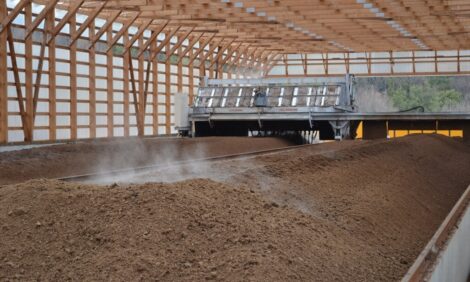



Weekly global protein digest: report on China's poultry industry, China to sell more pork stocks
Analyst Jim Wyckoff shares an update on the US futures market, USDA reports and global protein newsWeekly USDA beef, pork export sales
Beef: Net sales of 15,200 MT for 2022 were primarily for China (6,200 MT, including decreases of 200 MT), Japan (3,200 MT, including decreases of 500 MT), South Korea (1,200 MT, including decreases of 700 MT), Mexico (1,100 MT), and Canada (800 MT). Net sales of 300 MT for 2023 were for Japan. Exports of 18,600 MT were primarily to South Korea (4,600 MT), China (4,300 MT), Japan (4,300 MT), Mexico (1,500 MT), and Canada (1,000 MT).
Pork: Net sales of 29,000 MT for 2022 were primarily for Mexico (15,500 MT, including decreases of 600 MT), Canada (2,300 MT, including decreases of 500 MT), China (2,200 MT, including decreases of 200 MT), Japan (2,200 MT, including decreases of 200 MT), and South Korea (2,100 MT, including decreases of 100 MT). Exports of 26,500 MT were primarily to Mexico (12,500 MT), Japan (3,200 MT), China (3,100 MT), South Korea (2,200 MT), and Canada (1,700 MT).
China to sell more pork stocks
China will release another 14,400 MT of frozen pork from state-owned reserves on Sept. 23, continuing its recent sales onto the domestic market to ensure adequate supplies amid rising prices as the country heads into its extended holiday season. In total, China plans to sell around 200,000 MT of pork from state-owned reserves.
USDA’s annual report on China’s poultry industry
In 2023, poultry production in China is expected to remain stable at 14.3 million metric tons. White feather broilers’ share of overall chicken production is expected to increase, while yellow feather broiler production is expected to decline. In 2023, imports (excluding paws) are expected to reach 750 thousand MT from lower 2022 rates. China currently restricts imports of select U.S. poultry and poultry products from several locations based on concerns over highly pathogenic avian influenza. China’s exports in 2023 are expected to increase 5 percent to 575 thousand MT as demand resumes in mature and new markets.
FAS China estimates for 2022 chicken meat do not vary from USDA Official estimates for production, supply, and distribution.
Production: In 2023, chicken production is expected to remain steady at 14.3 million metric tons (MMT). Demand for affordable chicken products, particularly white broiler meat, is expected to grow in 2023. Consumers’ shift towards a more diverse protein diet will drive demand for white broiler products and drive increases in production. Yellow broiler production will be negatively affected by consumer price sensitivity and China’s ongoing COVID-19 restrictions.
Consumption: In 2023, demand for poultry products, particularly white broiler products, is expected to increase from the institutional and retail sectors to reach 14.475 MMT, a 1 percent increase over 2022.
Imports: In 2023, imports of chicken meat (excluding paws) are projected to reach 750 thousand MT after declining in 2022. In 2022, highly pathogenic avian influenza (HPAI) outbreaks limited imports from multiple countries, including the United States – the second largest exporter of poultry products to China.
Exports: In 2023, exports of poultry products from China to Hong Kong, Japan and other markets are expected to grow by 5 percent to 575 thousand MT as demand by consumers in other countries returns to normal.
China pork imports rose in August
China imported 140,000 MT of pork in August, up 20,000 MT from July but still 50% less than last year. For the first eight months of the year, China imported 1.07 MMT of pork, down 63.6% from the same period last year.
US pork producers list industry priorities
The National Pork Producers Council (NPPC) held its fall Legislative Action Conference Wednesday and Thursday last week, meeting with their members of Congress to discuss pork industry priorities. Over the two-day event, NPPC said its producers asked lawmakers to:
- Trade policy: Press the Biden administration to join the 11-nation Comprehensive and Progressive Trans-Pacific Partnership and to negotiate an Indo-Pacific Economic Framework trade deal that addresses market access for and non-tariff barriers to U.S. products.
- Expand the H-2A visa program to year-round agricultural workers, including packing plant employees. Currently, the visa only allows for temporary, seasonal farm laborers.
- Pass the “Beagle Brigade Act,” authorizing a training center for dogs that can detect animal and plant diseases and pests at the country’s points of entry. Only the Senate must approve the measure; the House passed the bill earlier this year. Producers also asked that the Bureau of Customs and Border Protection agricultural inspection program be fully funded.
- Next farm bill: Fund in next farm bill the National Annual Vaccine and Veterinary Countermeasures Bank, the National Animal Health Laboratory Network, the National Animal Disease Preparedness and Response Program, and the National Veterinary Stockpile. Producers also asked for an increase in funds to help reduce the population of feral swine, which can carry foreign animal diseases.
- Trade promotion: Reauthorize and fund — also through the farm bill — the Market Access and the Foreign Market Development programs to promote U.S. agricultural exports and authorize a USDA catastrophic risk insurance program to help mitigate risks for pork producers.
August US milk production up 1.7%
US milk production in the 24 major States during August totaled 18.2 billion pounds, up 1.7% from August 2021. July revised production, at 18.4 billion pounds, was up 0.6% from July 2021. The July revision represented an increase of 53 million pounds or 0.3% from last month's preliminary production estimate. Production per cow in the 24 major States averaged 2,041 pounds for August, 37 pounds above August 2021. The number of milk cows on farms in the 24 major States was 8.93 million head, 11,000 head less than August 2021, but 8,000 head more than July 2022.
Chinese pork prices surge
China’s ag ministry says the price of pork in the country averaged 30.69 yuan ($4.43) per kilogram for the week ended Sept. 9, up 1.2% from the previous week and 69.4% higher than last year. China will release a record 200,000 MT of pork from state reserves this month to boost supplies and stabilize prices.









